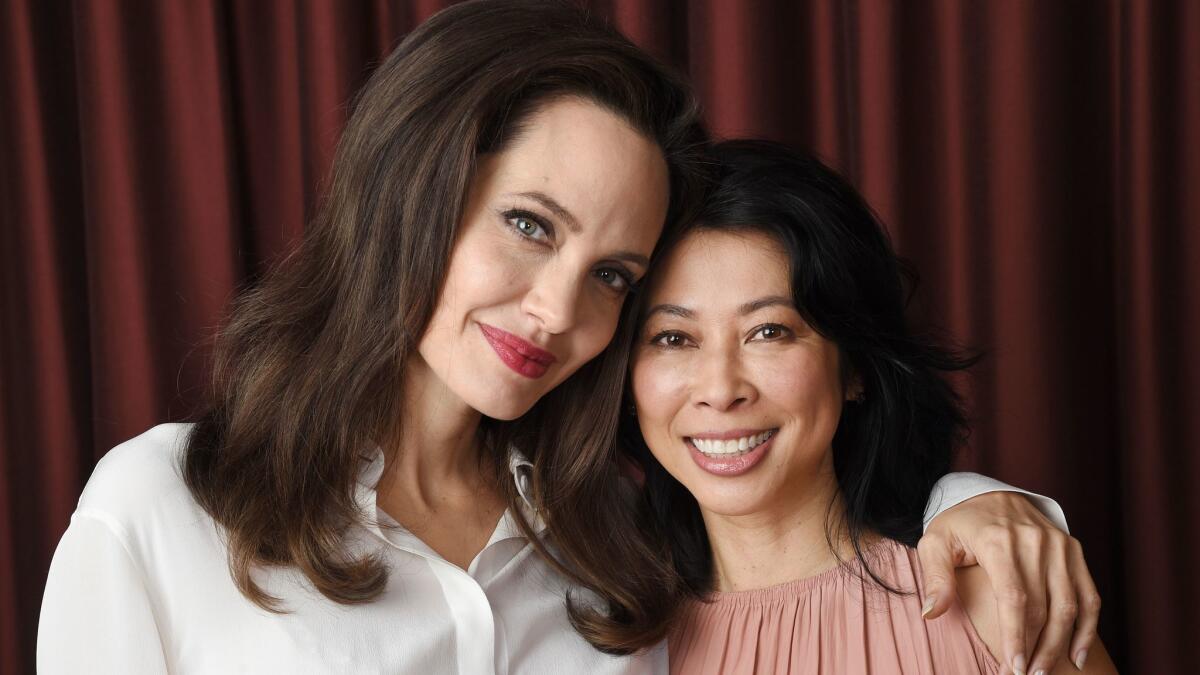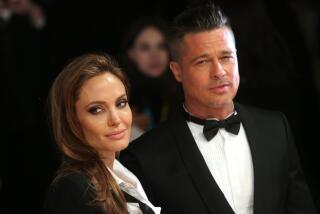Angelina Jolie follows her passion with ‘First They Killed My Father’

- Share via
Reporting from Telluride, Colo. — On an early September afternoon, Angelina Jolie sat in a sunlit room in a scenic mountainside hotel, clearly feeling relieved.
The day before, Jolie’s latest directorial effort, the emotionally wrenching Cambodian-genocide drama “First They Killed My Father,” had its North American premiere at the Telluride Film Festival. The crowd gave the film the kind of reception any director would dream of, with cheers and tears in equal measure, while critics took to Twitter to proclaim it Jolie’s best work as a director.
It was an auspicious launch into the awards-season fray for the film, which was released by Netflix on Friday via streaming and in 10 theaters nationwide and has been selected by Cambodia as the country’s official entry for the foreign-language Oscar.
With the screening under her belt, Jolie could now take a breath and take in the rest of the famously low-key festival, which she was attending for the first time with her six children in tow, enjoying the freedom to walk around without being besieged by paparazzi or reporters lobbing prying questions about her recent split from Brad Pitt.
“I geeked out on Ken Burns,” she said brightly, picking at a plate of cheese and crackers beside her longtime friend, Loung Ung, who authored the 2000 memoir “First They Killed My Father” and co-wrote the film’s screenplay with Jolie. “When do you get the chance to do that?”
On its face, “First They Killed My Father” — a child’s-eye view of the horrors of the brutal Khmer Rouge regime that claimed the lives of some 2 million Cambodians — may seem an unlikely project for Jolie to have tackled. The film is entirely in the Khmer language and chronicles events that took place on the other side of the globe when she was just a toddler.
Yet for the 42-year-old actress-turned-director, it is perhaps the most personal film she has made — an attempt to recount a painful chapter in the history of the country where her 16-year-old adopted son, Maddox Jolie-Pitt, was born and where she has put down her own roots over the last two decades.
Jolie and Ung first met some 16 years ago through their work on the issue of land mines in Cambodia. For years, they had talked about someday bringing Ung’s story of surviving the so-called killing fields to the screen. But neither was at all sure it would ever actually happen.
“Loung was in no rush to have the film made, and we knew Maddox needed to be in the right place because he was going to confront a lot,” Jolie said. “He goes to Cambodia a lot, he sees it — but not like that, not in that way. And then one day Mad said that he was ready.”
Jolie’s path to “First They Killed My Father” had begun in 2000, when she traveled to Cambodia to star in a very different kind of film, the action blockbuster “Lara Croft: Tomb Raider.”
“When I got there, I realized I knew nothing about this country and I felt very ignorant,” she said. “I decided to buy a book and learn a little bit so I picked up a $2 copy of ‘First They Killed My Father.’ That was really the beginning of an education and an awareness of how little I knew and how much I needed to change my view of the world.”
Inspired in part by her growing love for Cambodia — where she would eventually buy a house, become a citizen in 2005 and work for environmental conservation, education and other causes — Jolie started working with the United Nations as a goodwill ambassador in 2001, devoting more and more of her time to humanitarian efforts around the world that continue to this day.
Nearly four decades after the genocide ended, the subject is still difficult for many Cambodians to discuss, let alone see reenacted onscreen. But Ung says she was confident that Jolie would be able to do her story justice.
“Angie and I have gone through a lot in our friendship and I trust her as a woman, as a friend, as a filmmaker but also as a mother,” Ung said. “She has a track record, not just with me but with Cambodia and with the world, confronting tough issues of war and peace and refugees. So I knew she was somebody who would understand and pay careful attention and be very kind.”
Still, for Ung, who lost both her parents and two sisters in the genocide, watching the most traumatic events of her life play out onscreen for the first time, with young actress Sareum Srey Moch depicting her journey from carefree 5-year-old to orphaned child soldier to psychologically scarred survivor, was emotionally difficult.
“I went into it willing myself to be strong,” said Ung, who was sponsored by a church group after the war and resettled in Vermont and is now a human-rights activist. “I prepped myself for the hard scenes, the bombs and the soldiers and the land mines. But I found that the scenes that broke me the most were the first scenes with the family sitting down together for dinner. It was as simple as that. To see all nine of us at a table, just eating a meal — moments like that brought it back to what it’s all about, which is the love of family and all of us trying to survive together.”
Shooting the film in Cambodia in what became the largest production in the country since the war, Jolie drew upon every tool she had learned directing her previous features, 2011’s “In the Land of Blood and Honey,” 2014’s “Unbroken” and 2015’s “By the Sea.”
“I think I settled more into a voice,” she said. “Maybe it’s because of Maddox, I don’t know, but I feel like I broke from the box a little bit and I felt bolder in the choices. I think just that little bit more confidence than I had before helped me to stay calm and let things happen on set.”
As for Maddox, Jolie said that working on the film, on which he is credited as an executive producer, put him more deeply in touch with his Cambodian heritage. “I never wanted to press on him that he had to be connected or had to love Cambodia,” she said. “That had to come naturally, and he had to confront a lot of hard realities of what his birth parents had probably lived through. But what happened was, yes, there was a lot to learn but he made something. He created something with his fellow countrymen. He was part of a Cambodian crew, part of a Cambodian film, as a Cambodian.”
Though it’s safe to say that “First They Killed My Father” is not a film that most Hollywood studios would have jumped at the idea of making, Netflix agreed early on to back it. “It is true that this type of film would be difficult to make at a major studio because it it lacks star power and is in a foreign language,” said Scott Stuber, who oversees Netflix’s growing slate of original feature films. “We are fortunate because, for us, we have over 100 million members around the world who have unique and diverse tastes, and we have seen the power of good storytelling traveling globally.”
That said, Jolie is aware that a film about a genocide that took place decades ago in a country many Americans would have difficulty finding on a map may not necessarily be the easiest sell to domestic audiences, particularly these days. As someone who is deeply concerned with the rest of the world, she says the strain of isolationism that has taken hold in this country’s political life troubles her.
I think America is built on diversity and when we are at our best we are engaging in the world, pushing, representing something.
— Angelina Jolie
“Maybe it’s because I wake up in the morning and my children are from many different countries and we travel in the world,” she said. “I live in the world. I’m proud to be American but I’m also proud to be Cambodian. I’m proud my daughter [Zahara] is Ethiopian. I think America is built on diversity and when we are at our best we are engaging in the world, pushing, representing something. And when we’re not able to do that, the damage that can have — how that spreads into all the other crises and conflicts and human-rights abuses in the world — is something we all need to be very aware of.”
Clearly energized by her experience making “First They Killed My Father,” Jolie said she is eager to find another project to direct. “I prefer being behind the camera,” she said. “I’ve never loved being in front of the camera. I’m much happier when I’m watching other people work.”
But she is looking for the right thing to spark her interest. Asked if she has ever considered trying to tackle a big-budget studio franchise film, like a superhero movie, she paused.
“I don’t know how good I’d be on that,” she said. “Those are more the ones I’d act in — that’s funny, isn’t it? But no, when you give two years of your life, I want to learn something. I want to be immersed in a culture or be learning about history.
“To direct something, you have to be so passionate. You have to live and die for it if you want to make it great. Some people are passionate about those big entertainment ones or new technologies. I’m passionate about country and culture and human beings.”
Twitter: @joshrottenberg
More to Read
Only good movies
Get the Indie Focus newsletter, Mark Olsen's weekly guide to the world of cinema.
You may occasionally receive promotional content from the Los Angeles Times.











